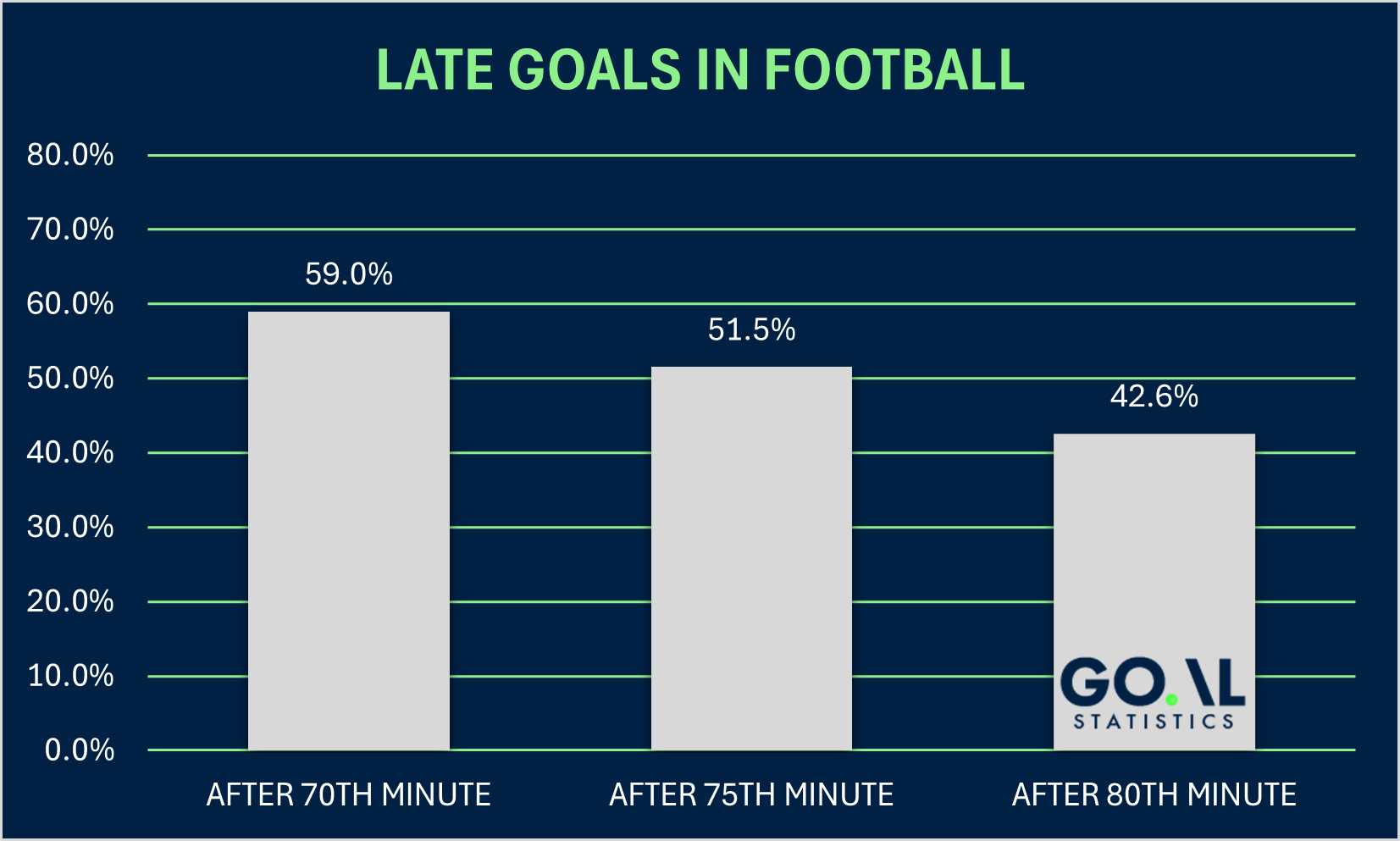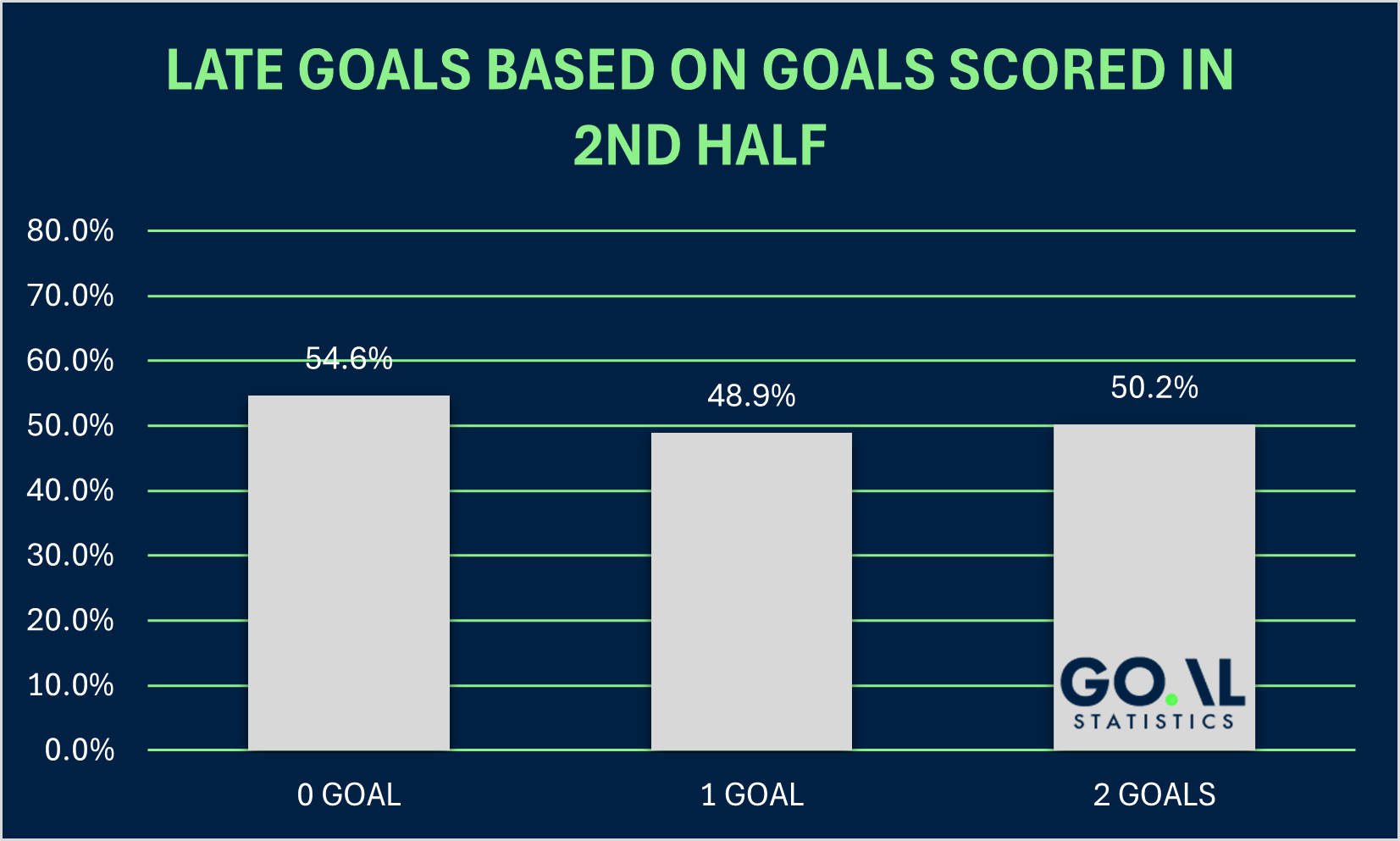Late Goal Stats And Strategy

Late Goal Stats & Strategy – Introduction
More often than not, the last 15-20 minutes are the most exciting period of a football match. A late equalizer or a last-minute go-ahead goal can make or break a bet, but how can you end up on the right side? In this article, we’ll discuss how to prospect and find the best games for your late goal strategy using our late goal stats.
How Frequent Are Late Goals In Football?
Regardless of the scoreline, there is at least one goal after the 70th minute more than half of the time! If we look at the 75th minute, it’s still above 50%. After the 80th minute, there is a bigger drop in terms of goal probability, as the teams managed to score ‘just’ 42.6% of the time. It’s still a lot, especially if you consider that there are only 10 minutes left from the regular time.

Available Late Goal Stats At Goalstatistics
We at Goalstatistics provide match specific football stats for certain live trading or live betting spots. For late goals strategy, you can use our late goal stats which can be found under the 75th-minute tables. We break down the stats into 3 different categories:
- Home Lead
- Draw
- Away Lead
It’s really important to mention that these categories contain statistics only from those games, where the specified situation had occurred. E.g. Home Lead category contains stats only from those games, where the home team had the lead in the 75th minute.
These categories contain more or less similar stats, these are the following:
Games Played
This is fairly simple, it shows the number of matches for each team in a certain category. As the sample size is key, this should be the very first stat you check. The higher the sample size, the more confident you can be. To make your life easier, our color-coding system takes sample size into consideration. Where the sample is below 3 games, the red or green highlight is lighter.
76-FT Goals
This is a stat to display each team’s performance in the last 15 minutes of a match (+ added time). You can see how many goals a team scored and conceded in a specific situation. This stat can be also used to find some sneaky plays! If a side is significantly better in a certain spot, you can back them, or lay the opponent on the Match winner market.
Home Team Scored
It’s a very significant stat, it shows how often the home team scored (and how often the away team conceded) at least one goal after the 75th minute in a certain spot.
Away Team Scored
It’s similar to the previous one, but in this case, it shows how often the home team conceded and how often the away side scored.
1+ Goal In Last 15 Mins
Probably the most important one. It shows the frequency of at least one goal scored by any of the teams after the 75th minute in the specified situation.
2+ Goal In Last 15 Mins
And finally, in case you are chasing crazy high prices. It shows the frequency of at least two goal scored by any of the teams after the 75th minute in the specified situation.
The Importance Of The Scoreline
You may wonder why do we break down the stats into so many categories. The answer is simple: it is important from the perspective of the late goals! To highlight the importance of every single spot, we check our football database.
Late Goals With Home Lead, Draw, or Away Lead
If you look at the numbers, you can see there are more late goals when the score is a draw at the 75th minute. It sounds surprising, as both teams get one point with a draw, and that’s a slice from the cake. It’s also important to mention that late goals are a bit more probable when the away team is leading, compared when the home team is leading. It sounds legit, as the losing teams need to take more risk, especially at home, in front of their own crowd.
Late goals based on the number of goals between HT and the 75th minute
Looking at the number of goals scored in the 2nd half up until the 75th minute also shows a significant difference. Many punters tend to bet on late goals only if there were no goals in the 2nd half. If you look at the graph, you can see it’s correct, as a late goal is more likely if the 2nd half didn't produce goal(s) yet.
All in all, we must say that certain teams and coaches tend to play more open in certain spots, while others don’t. By using our late goal stats, you can make more informed decisions.


Late Goal Bets – When To Enter The Market?
Now that we’ve run through all the important factors of our late goal strategy, it’s time to discuss when to enter the market. As a rule of thumb, the 75th minute is a good entry point, as most of the time, you’ll get a healthy price on over. On the other hand, just because the late goal stats are based on the 75th-minute scoreline, it doesn’t mean you can’t enter earlier or later.
When to Place a Late Goal Bet Earlier?
First of all, we need to specify what “earlier” means. Based on the stats we use, we suggest placing your late goal bet no earlier than the 70th minute. There could be several reasons to enter earlier. Firstly, you might already like the odds the market offers. If you enter earlier, you ‘buy’ more time for that goal. On the other hand, it is possible that you picked an action-packed game, and you want to get in as early as possible.
When to Place a Late Goal Bet Later?
By ‘later’ we mean around the 80th minute. By this time, the odds on over will be higher, and there is still a good chance to find a goal. You can decide to delay your entry if you’re unhappy with the odds, or the teams are not producing as many chances as you expect. By delaying your entry, you not only get higher odds, but you’ll get extra information too. If the teams suddenly start producing chance after chance, it’s time to enter!
When to Skip a Late Goal Bet?
Believe it or not, stats are not everything. Football statistics can help you to prepare a shortlist of games to follow. Just because a match is on your shortlist, you can still decide to skip it and move to the next one. Even if you did your homework, and you have the best games on your shortlist, you shouldn’t place a bet if you can’t see on the pitch what you want. And what do you want? High-probability chances.
A Note on Added Time
From the late goals point of view, the added time in the second half has a significant impact. The more time to play, the more goals a game can produce. Nowadays, when VAR is in place on pretty much every single football pitch, you can see more and more extreme examples of added time. If you follow a match, make a note every time when there is a VAR check in progress. If there is a borderline decision on whether to enter the market or not, a good estimation of added time can be helpful.
Late Goal Stats & Strategy – Summary
Betting on late goals is a really exciting strategy. In order to succeed, you need to create a powerful shortlist of games to follow. Our late goal stats can be very-very helpful, especially if you download our excel sheet with the upcoming fixtures. Our stats contain pretty much everything you need to know about the teams to help you more informed decisions. On the other hand, we strongly advise you to follow those games closely and be very selective.